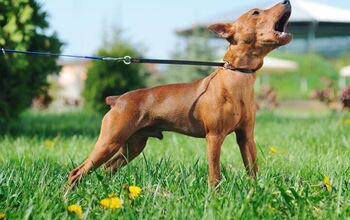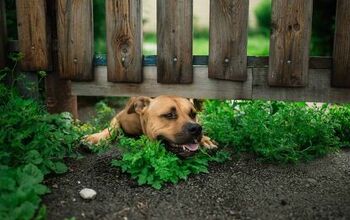How To Stop Your Dog From Eating Your Plants

It can be frustrating when your dog frequently damages your hard work in the garden. Whether it digs up the soil or eat your plants, it must stop. Understandably, you may struggle with how to stop your dog from eating your plants.
Spray your plants with diluted lemon juice to stop dogs from eating them. Ultrasonic repeller devices and sprays that feature citronella and thyme can also keep dogs away from plants. Move your potted plants if they’re at eye level with your dog, so they don’t eat them. Otherwise, simply play with your dog more so it's less likely to act on impulses.
It also helps to add more nutrients to your dog’s diet. That way, it won’t want to supplement its diet with food it shouldn’t eat. Follow along as we explore how to stop dogs from eating your plants.
How Do I Stop My Dog From Destroying My Plants?
You can stop your dog from destroying your plants with both household and store-bought remedies. The key is to make your dog want to avoid eating your plants altogether. Luckily, many of the best ways to stop dogs from eating your plants are easy, such as:
1. Use Lemon Juice
Lemon juice is delicious, but dogs don’t agree. Simply spray some lemon juice on your plants so your dog doesn't eat them. The smell of citrus alone is enough to stop most dogs from destroying plants.
Lemon juice shouldn’t harm your plants, but you shouldn’t use too much of it. The acidity in strong doses can discolor the leaves on your plants. You can also dilute the lemon juice with water so you don’t leave such a bad taste in your dog’s mouth.
2. Enclose Your Plants
Is it too easy for your dog to access your plants? If so, the best way to stop dogs from eating your plants is to block them off. You can easily protect your plants from your dog with some chicken wire or a simple fence.
Depending on how big your dog is, a simple DIY fence may be all you need. That said, big dogs can easily get around low fences. Steel fences offer the most durability, but vinyl is cheaper and easier to install.
3. Enrich Your Dog’s Diet
Dogs are in tune with their bodies, and they can often tell when they need nutrients they lack. That may explain why they constantly try to eat your plants. In that case, it’s a great idea to add a balance of vitamins, proteins, and minerals to their diet.
Dogs need plenty of protein, minerals, fats, and amino acids in their diet. Your dog may also eat your plants because they simply need more water. It’s always a great idea to keep several bowls of water in your house so your dog is never dehydrated.
4. Exhaust Them
Your dog likely eats and destroys your plants because it has lots of energy. You can often avoid this if you play with it a lot and exhaust your dog. Adult dogs need at least 30 minutes of playtime per day for their physical and mental health.
Keep in mind that it varies based on age, size, breed, and health. That said, even the bare minimum of activity is great to enrich your dog’s life. Your dog may still try to eat your plants, but you can distract them if you throw a ball or give them attention. The more bored your dog is, the more likely they are to act out.
5. Ultrasonic Repellers
Ultrasonic repellers help keep several types of animals away from plants, and that includes dogs. These small devices emit frequencies that humans can’t hear, but many animals can. You can easily stake them in the ground near your plants.
Once your dog approaches, the ultrasonic repeller will produce a sound that scares them away. This is a humane way to keep dogs away from your plants. The sound may temporarily make them uncomfortable, but it won’t hurt them.
You can keep ultrasonic repellers inside or outside. That said, make sure that the repeller you choose is rated for both indoor and outdoor use.
6. Move Your Plants
Do your dogs constantly eat your indoor plants and outdoor potted plants? If so, it’s likely too easy for your dog to access the plants. Any plant that is at eye level with your dog is at risk of being eaten, so it’s time to move them.
You can even simply put a taller base beneath the pot to raise the plant. The ideal location for your plants ultimately depends on how big your dogs are. You can also dedicate a room in your home or part of your yard to plants that your dogs can’t access.
7. Use A Repellent Spray
While lemon juice is effective, some dog owners prefer to use a store-bought repellent to protect their plants. You can find countless safe dog-repellent sprays that let you protect your plants both inside and outside your home. Many of these sprays contain common household items, like castor oil, thyme, and citronella.
A little bit goes a long way, so you don’t need to oversaturate your plants. They don’t smell bad to humans, but dogs will notice the smell. Most dogs and cats are unlikely to even bite the plants because the smell is so strong to them.
If they bite the plants, however, they will regret it and shouldn’t try again.
8. Train Them
Dogs respond well to training, and you can curb nearly any bad behavior. Keep in mind that overly negative reinforcement isn’t helpful for dogs. Instead, you should try to find a balance between stern and positive.
For example, you can stop many dogs from eating plants if you simply clap and say “no” or “stop”. You can even keep a spray bottle near your plants to gently spray your dog when they destroy your plants. Eventually, you’ll only need to grab the spray bottle without spraying your dog, and they should stop.
Summing it Up
You can easily stop your dog from eating your plants if you spray the plants with lemon juice. Store-bought repellent sprays with castor oil, citronella, and thyme can also keep your dog away from your plants. It also helps to play with or walk your dog for 30 or more minutes per day. This will exhaust it and stimulate its brain, so it don’t want to destroy your plants.
Related Guides:

Nick Durante is a professional writer with a primary focus on home improvement. When he is not writing about home improvement or taking on projects around the house, he likes to read and create art. He is always looking towards the newest trends in home improvement.
More by Nick Durante



























